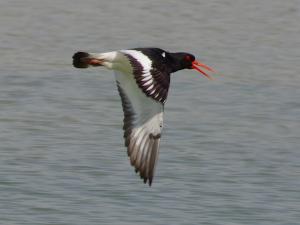


Sterland and Whitaker in their "Descriptive list of the birds
of Nottinghamshire {1879}" write that the Oystercatcher was sometimes
shot in the mid-nineteenth century. Austen Dobbs in "The Birds of
Nottinghamshire {1975}" called the Oystercatcher in Nottinghamshire a
rare passage migrant and vagrant, most years
.
From the 1940s there was a national increase and spread of the Oystercatcher "Atlas of Breeding Birds in Britain & Ireland {1976}" and from the 1980s it became a regular breeder in Nottinghamshire, especially in the Idle valley and Lound. Around 2 dozen pairs of Oystercatchers now breed yearly.
Oystercatchers have three types of bill, pointed, chisel-shaped, and blunt. The default type is pointed but individuals can change their shape depending in their food choice. See "Differences in bill form of the oystercatcher" (C. Swennen, L.L.M. De Bruijn, P. Duiven, M.F. Leopold and E.C.L. Marteijn) {1983}
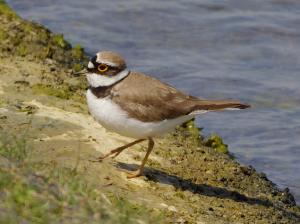
The Little ringed Plover is classed as a fairly common passage migrant, which breeds regularly on old colliery sites and gravel pits. The success and number of breeding pairs varies from year to year but is something like 30 or 40 pairs.
As the Little ringed Plover was a national rarity before it first bred in Britain in 1938, it is not suprising that Sterland and Whitaker never mentioned it when writing in the 19th century. Austen Dobbs wrote ("The Birds of Nottinghamshire {1975}") that it first bred in Nottinghamshire in 1956 and by 1971 39 pairs were present.
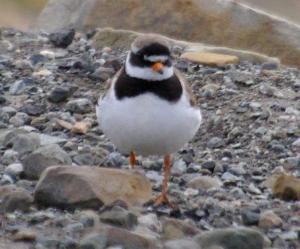
Both Sterland and Whitaker in their "Descriptive list of the
birds of Nottinghamshire {1879}" record it as being occasionally shot in
the mid-nineteenth century. By 1975, Austen Dobbs said in "The Birds of
Nottinghamshire {1975}", that the Ringed Plover was a fairly common
passage migrant
, which occasionally attempted to breed.
Since the 1950s there has been a tendency for the Ringed Plover to nest inland away from its original coastal habitat. This may be because of increased human disturbance at the ‘seaside’. Nowdays it has become a regular breeder in Nottinghamshire with a dozen or so pairs breeding, usually in working or expired aggregate workings.
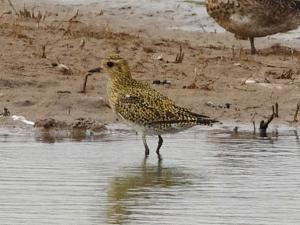
A common winter visitor in the nineteenth century, mainly on flooded fields by the river Trent. The favoured wintering feeding habitat of Golden Plovers is permanent pasture, which has been reduced somewhat in Nottinghamshire in the past sixty years. Their favourite food is apparently earthworms and they often share the feeding areas with Lapwings and Black-headed Gulls. As well as feeding areas, the Golden Plover also uses ‘loafing’ areas. Some ‘loafing’ places are Bennerley (recently numbers have reduced considerably here), Netherfield Lagoons (much reduced numbers here also, because of the expansion of the reedbed) and Lound. They can be seen in in large numbers at Gringley Carr, and in smaller numbers in south Nottinghamshire at Barton and Clifton pastures.
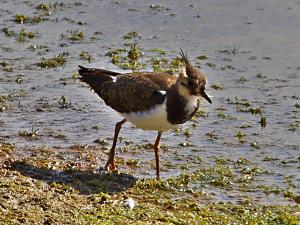
In Nottinghamshire the Lapwing is a bird of open farmland – both arable and pasture. It will use gravel pits to ‘loaf’ about in.
Has several older names such as Peewit (from its call) and Green Plover. W. J. Sterland in his "Descriptive list of the birds of Nottinghamshire {1879}" says that it was abundant in suitable habitat, but he never saw it after November in the hard Victorian winters.
By the time Austen Dobbs edited "The Birds of Nottinghamshire {1975}", times had changed for the Lapwing. The general milder climate of the time encouraged the Lapwings to stay in some numbers for most winters, but the use of agricultural machinery earlier in the year and the draining of pastures had reduced the breeding population.
In the early 21st century the decline of the Lapwing as a breeding bird has continued, and also there are less passage and wintering birds since the mid-1990s. It is still common enough however and a few birds even stayed throughout the 2010/11 hard winter.
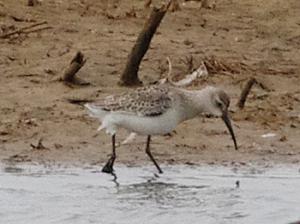
The Curlew Sandpiper is regarded in Nottinghamshire as an uncommon autumn migrant with the numbers varying each year. Some years there are no records. When the Nottingham Sewage Farm was an artificial marsh, numbers were higher with 100 birds present on one day in 1946.
What could happen if suitable wader habitat was present was shown in early September 1998, when problems at the Stoke Bardolph (the present name for the Nottingham sewage works) sewage works, caused the flooding of an adjacent field and 20 to 30 Curlew Sandpipers were present for several days, along with other waders.
Sterland said in the "Descriptive list of the birds of Nottinghamshire {1879}", that he knew of 3/4 individuals which had been obtained in the late nineteenth century.
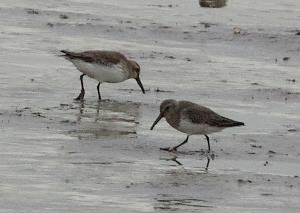
In the "Descriptive list of the birds of Nottinghamshire
{1879}" Sterland says the Dunlin was frequently obtained (shot/trapped).
It was probably even more common in the 1940s/1960s when it was called a
common passage migrant
, with flocks of up to 200 birds at the old style
Nottingham Sewage Farm in the autumn.
Nowdays, the Dunlin is still a common enough passage migrant, but not as common as previously. This is due to the lack of suitable habitat for it to linger any length of time whilst it is on passage. Nowdays old quarries such as Kilvington are the main spots to see them.
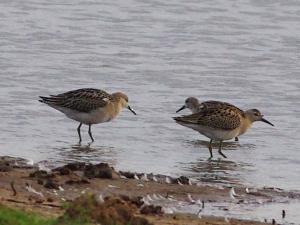
The Ruff is a fairly common passage migrant in Nottinghamshire (March–May and July–October) which can sometimes overwinter. They will feed on insects in the muddy margins of pools, lakes and mining flashes. A couple of dozen birds were present at the overspill at the modern Nottingham sewage farm in September 1998. Also in the early autumn of 1988 up to a dozen birds were present in a flooded field not far away by the river Trent.
Very rare in Nottinghamshire in the mid-nineteenth century, it has increased in numbers since then. The Ruff first wintered in Britain in the 1930s and must have loved the habitat at the old Nottingham sewage farm in the 1940s. Lound, Kilvington and Collingham are probably the best places in Nottinghamshire to see it nowdays.
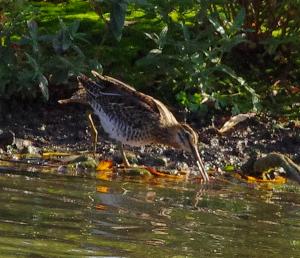
The Common Snipe was a plentiful winter visitor to Nottinghamshire in the mid-nineteenth century and it also sometimes bred. It became a more frequent breeder in the late nineteenth century, but the draining of damp meadows and marshy grounds in the 1930s reduced the breeding population.
In the twenty-first century the Common Snipe still breeds in small numbers and winters again in smaller numbers than previously. New wetlands, such as Beckhamton Marshes will hopefully increase the numbers in Nottinghamshire.
Most of Nottinghamshire's wintering Common Snipe come from the Baltic countries. It can lay down body fat in the winter so that it can survive short cold snaps of weather for up to a week but ultimately prolonged hard weather will drive the Snipe out of Nottinghamshire to the south and west.
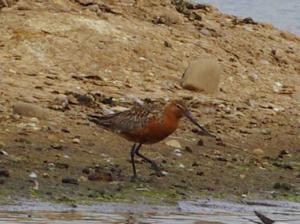
The Black-tailed Godwit was recorded two or three times in
Nottinghamshire by Sterland in the "Descriptive list of the birds of
Nottinghamshire {1879}". In his "Birds of Sherwood Forest
{1869}" he said not uncommon on the banks of the Trent in the
neighbourhood of Nottingham
.
It was recorded more often in the 1960s/70s, this being part of a national trend from the 1940s of increased wintering in Britain and also from the return of breeding birds to the Ouse Washes in the 1950s (The Wintering Population of the Black-Tailed Godwit {Prater 1975, Bird Study 22:}).
At the present time the Black-tailed Godwit is still a regular passage migrant with more birds in the autumn than in the spring. Sometimes large flocks of 50 or so birds pass through.
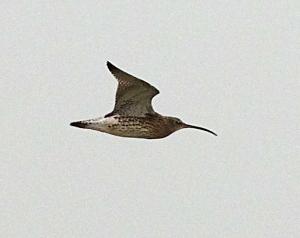
Sterland in the "Descriptive list of the birds of Nottinghamshire {1879}" regarded the Curlew as a regular spring visitor. By the time of the "The Birds of Nottinghamshire{1975}", Austen Dobbs was able to say that the Curlew had both arrived as a breeding bird in Nottinghamshire and had almost disappeared as one.
Originally the Curlew was an upland moor breeder, but from the early 20th century it started to spread to suitable lowland sites. It was first noted as breeding in Nottinghamshire in 1945 (Trent Valley Birdwatchers report), numbers rose to over a dozen pairs. A wetland survey by the TVBW and others in 1982 found 12 pairs.
But with the modernisation of the Nottingham Sewage Farm in the 1960s and the draining of the Idle and Soar valleys in the late 1970s, its status became an uncommon passage migrant and winter visitor and an occasional breeder, a situation which still exists today.
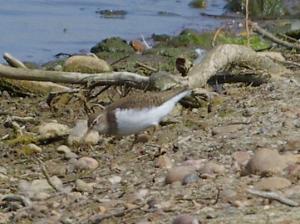
W. J Sterland in the "Descriptive list of the birds of Nottinghamshire {1879}" says that the Common Sandpiper bred in a few localities in Nottinghamshire.
Later on in the twentieth century it was still a common passage migrant in the spring and autumn, but had ceased to be a breeding bird. In the first decade of the twenty-first century it is still a common passage migrant, stopping at any sandy or gravel spot by the water's edge. It does however now occasionally breed.
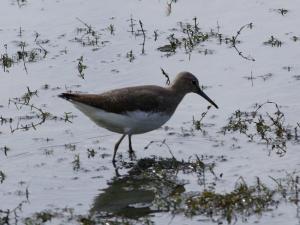
Sterland indicates that it was a rare visitor to Nottinghamshire in the mid-nineteenth century. By the time of Austen Dobbs "The Birds of Nottinghamshire {1975}", it appears to be slightly more common as a passage bird with a few overwintering. Nowdays it is more frequent between July and September than at any other time of the year. It can be found on aggregate pits, both derelict and working and also in ditches and other secluded water features.
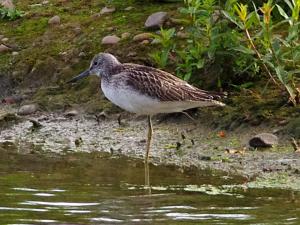
Sterland and Whitaker regarded this bird as an occasionally seen passage bird. Dobbs in "The Birds of Nottinghamshire{1975}" considered it a fairly common passage migrant. In the 2000s the Greenshank still has the same status with most birds being seen in August. Its stopping off places are the usual gravel pits.
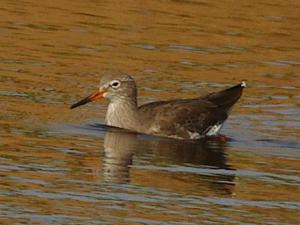
In the "Descriptive list of the birds of Nottinghamshire {1879}" Sterland says that a few pairs of Redshank occasionally bred on the western banks of the river Trent and around the river Idle in north Nottinghamshire. Nationally the Redshank extended its range greatly in the late nineteenth century, spreading westwards and Whitaker knew it as a common breeding bird by the early 1900s, especially in the Idle and Trent valleys.
In 1959 the Trent Valley Birdwatchers carried out a survey and it was considered that 100/113 pairs were breeding in the county. Another survey was carried out in 1982 and found 46 pairs of birds, the spring was very dry and would have had an effect on numbers for this damp grassland species.
Because of land drainage, numbers of breeding birds in Nottinghamshire has fallen considerably and is now about 10 or so breeding pairs a year. The work being carried out by the RSPB and others at Beckingham Marsh should increase the numbers of breeding birds. It still remains a fairly common passage migrant and wintering bird, however.
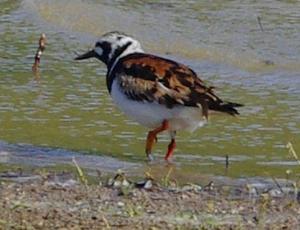
Sterland in the "Descriptive list of the birds of Nottinghamshire {1879}" says that he only knew of two being shot at Sutton-on-Trent. In "The Birds of Nottinghamshire {1975}", the Turnstone was considered a scarce passage migrant. Its spring passage generally happens in May and the return, Autumn passage, usually runs from the end of July and throughout August.
In the twenty-first century the situation is much the same as when Dobbs wrote thirty years before.
Any criticisms, corrections or comments to the author Derek Huskisson

This
work is licensed under a Creative Commons
Attribution-Noncommercial-Share Alike 2.0 UK: England & Wales
License.